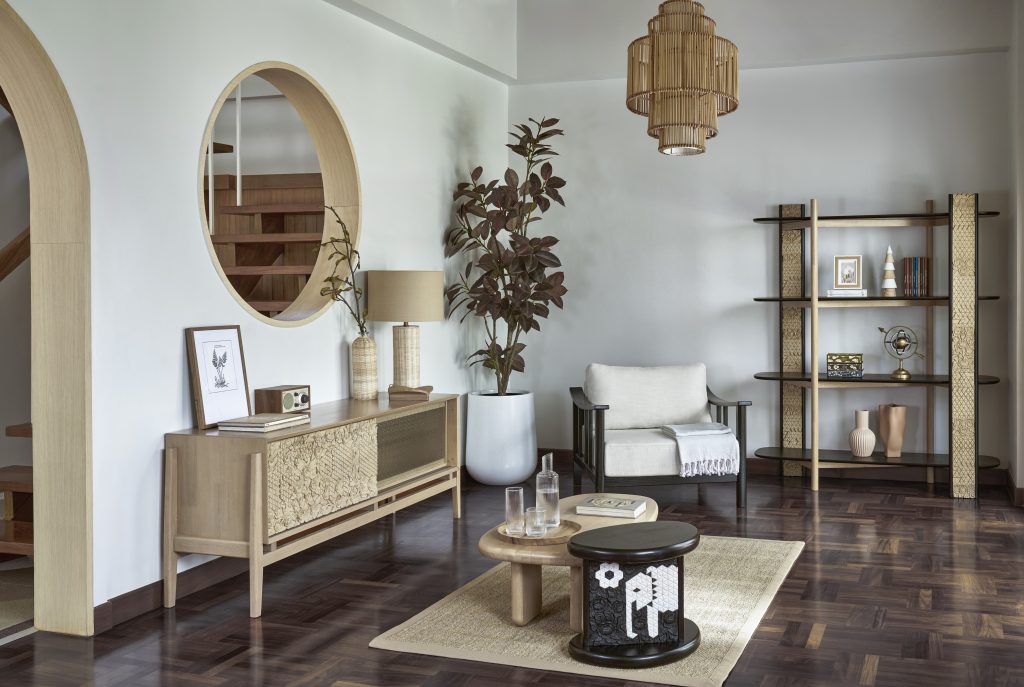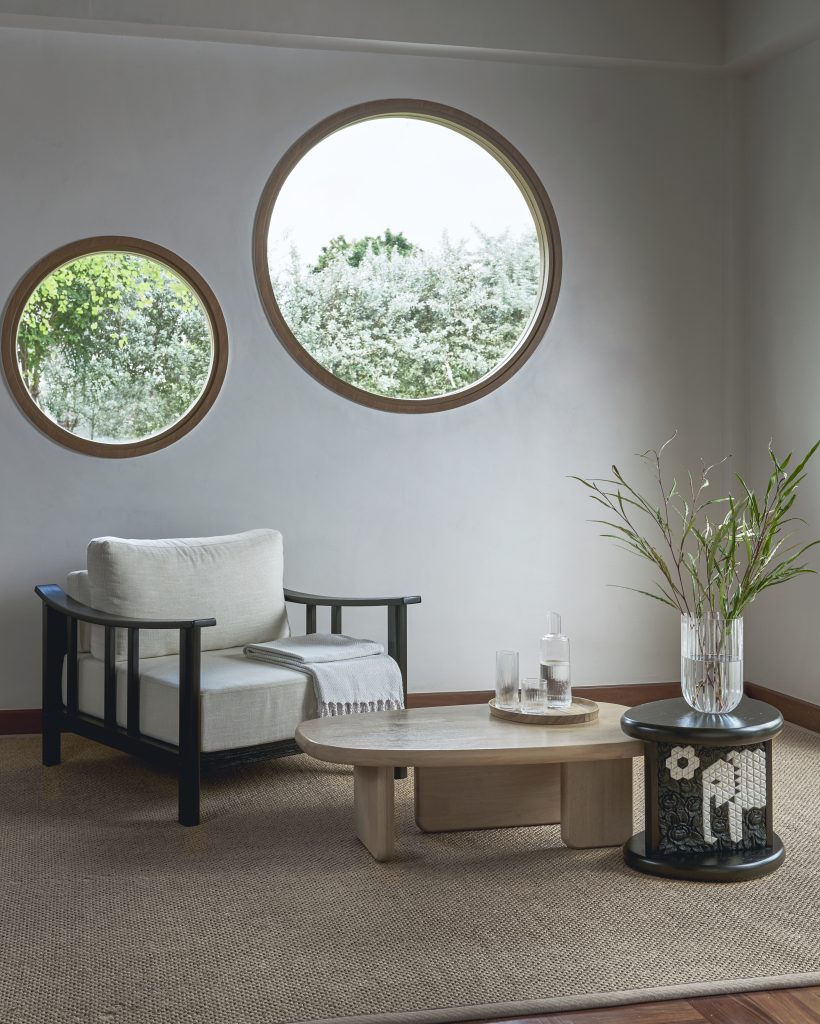“Index Living Mall Public Company Limited” (SET: ILM) continues the Company’s “1 Year, 1 Region” ESG (environmental, social and governance) mission for the second year to develop products together with local communities.
Most recently, the project co-developed products in the Northern region with the Woodcarving Culture Village of Ban Kiw Lae Noi in Chiang Mai Province’s San Patong District. The goal was to bring the charm and cultural wisdom of Lanna woodcraft that have been passed down from generation to generation for the past 60 years, highlighting the delicate and timeless woodcarving craftsmanship combined with “Living Furniture” innovation to create the “Kiang Tua” collection – a Lannavian design that maintains the local identity while perfectly meeting the needs of the current contemporary lifestyle.
The project also helps to elevate the grassroots economy, supporting income generation within the community, along with supporting the handicrafts from old cultural wisdom to be widely known, in order to create sustainable growth.
Miss Kridchanok Patamasatayasonthi, Managing Director of ILM, Thailand’s leading integrated retailer of furniture, home furnishings and decorative items, revealed that Index Living Mall continued to be committed to all ESG dimensions under the “Sustainable Living for Future Lifestyle” concept.
Most recently, ILM has continued with its mission to develop products in collaboration with local communities under the “1 Year, 1 Region” proposition. In the first year, the Company started in the Southern region with the collaboration with “Bai Mai Group” of Ban Khiri Wong community in Nakhon Si Thammarat Province, to further develop organic tie-dye fabric craft works into bedroom and living room furniture sets in the “Happy Vacation” collection.
For this second year, the Company has moved to the Northern region to co-create products with the Ban Kiw Lae Noi Community in San Patong District of Chiang Mai Province. This is a cultural village well known for its Lanna-style woodcraft created by Thai craftsmen who have been passed down the delicate beauty of their works through generations for the past 60 years to ensure that the 100-percent hand-crafted works survive and remain valuable works of art and utility. The distinctive patterns of beautifully-carved wood have been replicated in the “Kiang Tua” Living Room furniture collection, through the interpretation of the designs in contemporary furniture.
This is a perfect combination of local wisdom and modern elements in the designs to preserve the ancient art of wood carving and to immortalize local wisdom. To this end, Index Living Mall has combined the charm of Lanna art with the simplicity of Scandinavian design to create a collection that reflects simple beauty, warmth, and uniqueness, with the villagers of Ban Kiw Lae Noi playing an important role in the creative process and the success of this collection.
The inspiration behind the design of “Kiang Tua Lannavian Style” furniture collection has been derived from of the art that arose from the spirit and culture of Lanna, through the patterns and the body language of elephants, the idolized animal of the Northern people, together with the Pudtan (cotton rose) flower all combined to characterize the exquisite woodcraft of the Ban Kiw Lae Noi community. These have been collated with the geometric triangular wood carving technique on furniture pieces composing of four series, namely:
- Kiang Tao Cabinet: The carved-wood sliding door and the glass sliding door of the cabinet are decorated with Pigun (Mimusops elengi) flower motif that serves to add dimensions to the cabinet with intricate details and added warmth with soft light.
- Kiang Tao Shelf: Distinctive with its carved wood panels to showcase the delicate woodworking patterns.
- Kiang Tao Coffee Table & Side Table Set: Wood pieces have been designed with curves to simulate an elephant’s body in both the coffee table and side table, while the black side table is adorned with a carved panel in elephant pattern.
- Kiang Tao Armchair: The coffee-color wooden armchair has armrests that are curved to resemble an elephant’s trunk, while the thick cushions are soft and supportive for comfortable posture.
The design concept that conveys cultural background combined with contemporary style ensures that this furniture collection perfectly fulfills the lifestyle needs while supporting a wider customer base from Gen X to Gen Z (age 35-55 years) with income levels from B to A. It also responds to the environmental conservation trend now being espoused by all sectors, including both from the perspective of retail consumers and the business sector, especially the real estate and hotel businesses, which have been increasingly prioritizing the procurement of environmentally friendly products.
As a result, furniture in the eco-friendly, or green, furniture group will become increasingly popular. By the year 2030, the global eco-friendly furniture market is expected to be worth more than US$81.9 billion, or an average growth of 8.0 percent CAGR (2023-2030), almost doubling from 2023, in which it was worth US$47.8 billion. (Source: Krungthai COMPASS)
Miss Kridchanok further added that the field visit to interact with the community group in Ban Kiw Lae Noi became an amalgamation of knowledge between the artistic concept of woodcarving, industrial design, and viable production process, in order to develop this collection to be as complete as possible as has been visualized. It was a challenge that requires concerted study.
At the same time, the wood used for carving was mainly teakwood scraps from within the community that must be bonded to form single pieces while care must be taken to match the wood grains to bring out the beauty of the wood. The special technique was derived from the ancient wisdom of the community and required special expertise.
In addition, the design technique was applied to make the finished products look more contemporary by adding triangular groove patterns on the wood – a technique that ILM imparted on the community to integrate into the pieces to produce contemporary furniture that will appeal to a wider group of customers.
Furthermore, the “Kiang Tua” collection does not just meet the consumers’ lifestyles, but it also combines nature, culture, and people’s way of life together harmoniously, leading to true sustainability.
This is in line with ILM’s commitment to driving the business by adhering to the ESG concept in all aspects. For this project, it is also considered to be a development of social and environmental dimensions, both in terms of jointly preserving and sustaining Lanna wisdom and arts to ensure its survival, along with supporting the local economy.
The collaboration also helped to create environmentally friendly products by also using rubberwood, from rubber trees that can no longer produce latex, as the structural components of the furniture, while promoting the reuse of resources, such as teakwood scraps that, in the end, helped to create a sustainable society and environment.
Mrs. Amporn Srihata, leader of the Ban Kiw Lae Noi, wood carving community in Chiang Mai Province, said, “This is the first time that the Ban Kiw Lae Noi community group’s wood carvings have been developed and incorporated into large end products like furniture. This is new to us even though we have been involved in wood carving for decades. First, I must explain that Lanna wood carving has been a part of my family’s legacy for almost 60 years. The art has been passed down from generation to generation. In those days, I must first practice carving just Pudtan flowers. Therefore, I decided to incorporate the Pudtan flower into the design elements of carvings on the ‘Kiang Tua’ furniture collection.
“I also incorporated the elephant into the patterns as Lanna people respect the elephants as graceful and elegant animals that have long been interrelated with the Lanna way of life, from logging works to sharing our lives in the forest. It is as if the elephants are our closest friends. For the people of Ban Kiw Lae Noi community, it has been great fun working with ‘Index’ every step of the way. It was a good way to share experiences, while the community has gained knowledge from the perspective of industrial production. On the other hand, the community has also passed on knowledge from the perspective of wood carving, limitations, and various techniques of wood carving to the ‘Index’ team.
“I would like to thank the ‘Index’ executives and all the staff for giving the community group the opportunity to showcase their work skills on carved wooden furniture pieces and for becoming another channel to promote the Lanna-Thai culture to be more widely known and for further developing more work and generate income, while also helping to develop the potential of all woodcarving craftsmen in Ban Kiw Lae Noi. Every piece of furniture in this collection is the source of pride for us. I would like all art lovers to see for themselves and experience the carvings that we have dedicated ourselves to and have intended to convey in the furniture collection in Lanna-Thai style. I believe that ‘Kiang Tua’ will be a bridge connecting the warm and down-to-earth local culture with the contemporary era harmoniously.”







